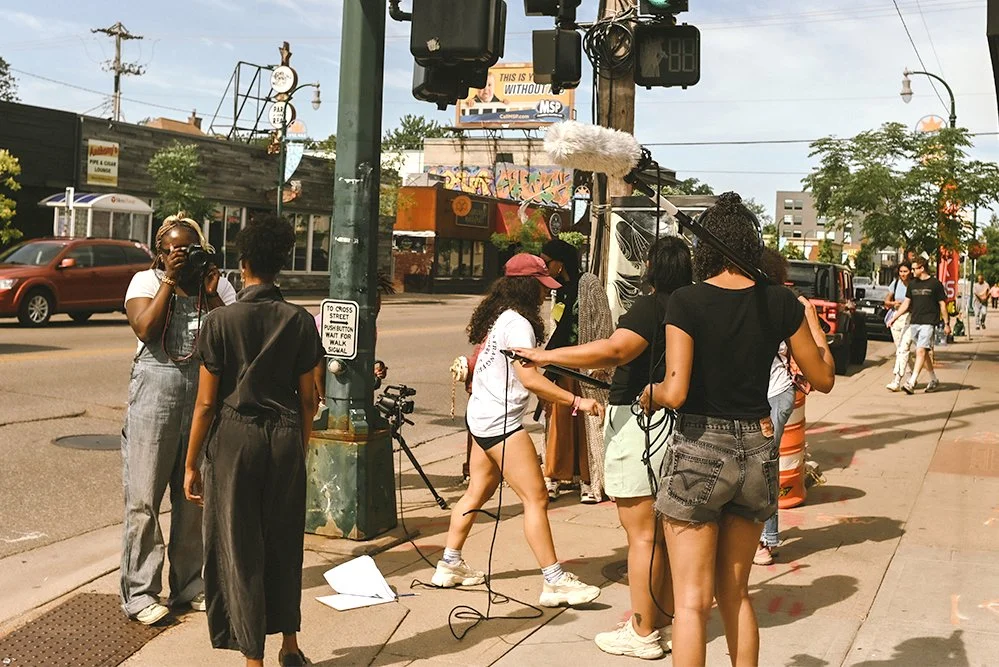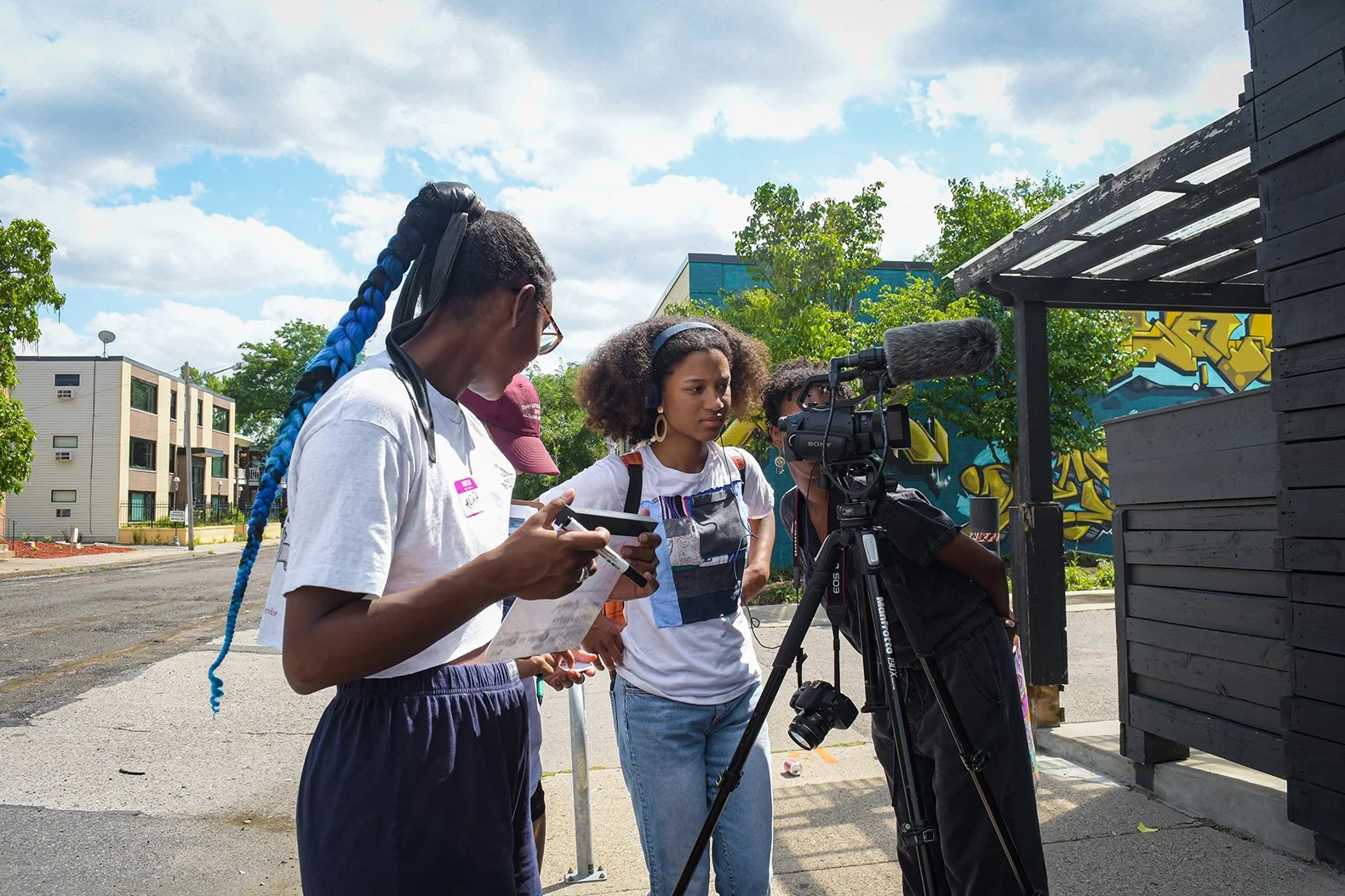Kismet Malaise, affirming Black women/femme artists in Minneapolis, one story at a time.
August 16, 2023 | Arts & Cultural Affairs
Kismet Malaise workshop participants on-location. Photo by Cynthia Abalo.
Filmmakers Sophia Abrams and Anna du Saire envision an ecosystem of community and collaboration and in an environment where no one is afraid to fail.
In August of 2023, The City of Minneapolis’ Arts & Cultural Affairs announced funding through the Creative Response Fund for 12 artist-led teams for projects providing creative healing and support to Minneapolis communities that continue to be directly impacted and affected by the stress and trauma of 2020.
For Creative Response Fund recipients, Sophia Abrams and Anna du Saire, screenwriting functions as a portal into the world of filmmaking — a process requiring a level of vulnerability, flexibility, and trust in community. In a city with few Black women/femme filmmakers, Sophia and Anna are focusing their talents on cultivating screenwriters via learning workshops and location film production experience in Minneapolis. Inspiring participants to craft screenplays from their own personal lived experiences will be a positive step in presenting original voices and important stories to the film community and audiences in Minneapolis.
Interviewed and written by Liz Pangerl, consultant for Arts & Cultural Affairs. This article has been edited for length and clarity.
How did the two of you meet?
Sophia: At the Reload.it “In Her Direction,” panel talk with women in music and film last year in Northeast.
Sophia Abrams and Anna du Saire
Anna: At the panel session for “In Her Direction” for Black women directors, we shared notes on some of the projects we were each working on. We continued to meet and eventually became accountability buddies so we could support each other and check in on how our projects were progressing.
What does Kismet Malaise mean?
Sophia: This past January I was working on a few scripts. I typically write about young people with stories that tend to be personal, and I thought of the word, kismet. For me it’s about what it means to be an artist in any capacity. An artist needs some luck, and the ability to trust people and find community. The process can be called kismet.
And malaise? I thought about young people coming of age in at atmosphere of malaise. Maybe it’s a physical malaise in a post vaccine landscape, especially for Gen-Zers like Anna and myself. During the pandemic everyone was in lockdown, and for anyone lucky enough to still be here, the question became, where do we go now?
The theme kismet malaise is pertinent to our film project. With the actor’s strike, the future is unknown for those who work in the industry.
“The title Kismet Malaise speaks to how Gen-Zers are feeling, especially those working in film or pursuing the arts more broadly.” — Sophia
Most films have a tag line that clarifies an idea for dramatic effect. Will yours?
Anna: Maybe ‘small moments between artists,’ or maybe just ‘small moments.’ It’s about the everyday sublime interactions we engage in – which may seem mundane yet hold beauty and significance in them.
Sophia: We asked the participants at the beginning of the project what kismet malaise meant to them – as a way of keeping it open-ended, because it can mean different things to different people. We asked the question again at different points of production, and in the workshop, so we’ll see how it evolves.
Your first workshop was held on Sunday, August 6th for selected participants. How did it go? What was their experience like?
Workshop participants in conversation. Photo by Cynthia Abalo.
Sophia: It went well. We held a three-hour session at a library in Central Minneapolis. We began with a presentation on Black women directors from the 1970s to present-day and then focused on screenwriting basics during the second half. We also Zoom recorded the session for previewing again and for the few who couldn’t make the workshop.
Anna: When we were on location, it was cool because we interacted so much more and were focused on filming, while the workshop allowed for more ideas and conversations to take place without distractions or fear of limitations.
The workshop curriculum is robust with plenty of homework for your emerging screenwritiers? Can you share a little about that?
Sophia: Our teaching style is to include interactive ways in which the participants can learn the basics of screenwriting, and comprehend the filmmaking process. The assignments include listening to podcasts, watching movies and interviews and reading — all created to offer a broader view of Black women in film and film in general.
How are the participants feeling about writing their own scripts?
Sophia: A few had some screenwriting experience. Some had more solidified ideas, while others didn’t. The brainstorming session at the first workshop was around ideas, goals, and structuring the screenplays so that if participants choose to — they can go into production with it.
“One of our goals is to cultivate a healthy, productive, and supportive film community.”
— Anna
How do you expect the workshopping and on-set experience to impact participants individually and as new creatives in film making?
On location. Photo by Zoé Challenger.
Anna: I hope the participants can eventually produce the short films they write, and in the process lean on each other during the screenwriting workshops for encouragement and feedback. The entire process has the potential to strengthen and empower Black women and the femme film community in Minneapolis. We ourselves are a community now too, so if we see each other on a job around the city or on a set, we’ll have our kismet connection. We can network, share resources, opportunities, and attend each other’s screenings. If someone needs feedback on their screenplay, or help with film equipment, or a crew in the future, we’ll be there for each other.
“We will support each other no matter what level of experience each brings to the workshops.” — Sophia
Sophia: It’s an ecosystem of community and collaboration and in an environment where no one is afraid to fail, especially in film, which requires a level of vulnerability. We also want participants to understand the process and how it is manageable.
How did the actual on-location filming work?
Anna: Every workshop participant was a part of the crew. Sophia wrote the script, so we asked each person to read it, and to share with us what set position they were interested in learning and what aspects of filmmaking they wanted experience in. We shot the film over a weekend. Everyone played a part in the production and many switched roles. We had enough time and flexibility for each to be part of the audio/sound team, for example, to listen to the audio of scenes that were filmed. It was fun and collaborative. And now that filming is wrapped up, I can start the editing process.
“We know it’s hard to get on a set unless you are directly involved or know the right people or have some connections. We wanted to include participants in the actual shooting of the film, so they could get on-set experience right from the start. Typically, on-set work can be a barrier for getting into the industry. And, we had a full Black femme crew and set which rarely happens in our industry.” — Anna
How important is it to support Black women/femme filmmakers in Minneapolis?
Sophia: It’s so important. Creatives are scattered all around Minneapolis and are usually very busy, but I’ve met like-minded people at art galleries, art openings and other events. The main thing is to be in community, which can enrich each of us as screenwriters and filmmakers.
How has working on Kismet Malaise impacted your respective filmmaking practice?
Sophia: Filmmaking is such a collaborative art form, but that doesn’t mean there aren’t barriers to entry. Anna and I are just at the beginning of our careers and still learning. We admire a lot of writers and filmmakers, like Issa Rae (an American actress, writer, and producer), and Greta Gerwig (An American actor, screenwriter and director). They had to start somewhere too, so they were in community making projects with friends.
Those who are interested might not know exactly how to do it, but they will find a way. Filmmaking requires a lot of support and community can fill that role. It’s also about delegating different tasks on set so it’s good to know how to teach others.
Photo by Cynthia Abalo.
“Black women/femme filmmakers in Minnesota are a small but mighty group. Black women/femme people might not consider film because it feels out of reach, so hopefully our project will inspire other Black women to consider screenwriting and filmmaking.” — Sophia
Anna: Sophia’s right in that there are no negative aspects to us working together or working on our own projects. I've found that if an individual in the community is improving and winning per se, then the entire community is improving and winning. This project allows us to practice and improve on our skills, connect with others, and build relationships. And it’ll help us grow and learn as we move towards our own personal work. Our experiences so far have helped us gain confidence working within our community and this workshop group directly.
What will success look like once Kismet Malaise has its public screening in April of next year?
Sophia: For us, success really looks like the community we're building in these workshops, especially with the participants being both comfortable and vulnerable and open to trying and learning new things.
When we screen Kismet Malaise in April of next year, we want our audience to include everyone from the workshops, their families, and friends and all who are curious and interested from the greater community. I attended UW-Madison and returned to Minneapolis last year and found it initially hard to meet Black women/femme filmmakers, at least in a collaborative sense. Being part of and leading these workshops is exciting and affirming.
Photo by Zoé Challenger.
Anna: I think we’re already a success. Curating a Black women/femme crew on set is a success. Completing a shoot in two days with an entirely new crew is a success. Being in this space and part of a completely accessible community is a success. As the editor of the film, finishing it will be a success. Seeing it on screen as a final film with those in the audience experiencing a story like ours from start to finish will be a success.
“How often can you say that a crew of 18 Black women in film shot a short film over a weekend? It just doesn’t happen.” — Anna
One of my favorite moments from filming live was when we filmed a scene in a bathroom and after Sophia called, ‘cut,’ everyone cheered. It was like, yeah, let’s go! And that wasn’t even the final take! It was a shared moment of joy. A cherry on top of everything else.
What’s important as you move forward?
Sophia & Anna: Ongoing exposure for our stories and films and those of other Black women writers and filmmakers. It means having people interested, curious and following us and our work. We would also like to see more people support young artists, writers and filmmakers and to search us out.
“Find films that you like and then pay attention to that filmmaker. We all need viewers.”
— Sophia & Anna
About Kismet Malaise
Kismet Malaise is a short narrative film about Black women/femme artists in Minneapolis, and will be written, directed, and produced by Sophia Abrams with Anna du Saire as cinematographer and editor. The film will provide early-career Black women/femme filmmakers in Minneapolis an opportunity to learn and build their production experience, create a personal project, and remain (long-term) in the Black women/femme film community in Minneapolis. A workshop series will enable participants to be in a collaborative space that will teach basic screenwriting and film production – beneficial experience for future film projects.
About Sophia Abrams
Sophia Abrams (she/her) is a filmmaker, curator, and artist. In May of 2022, Abrams curated Black Expressions, Camouflage and Cologne, and Time(is) in spaces around Madison, Wisconsin. Sophia has produced documentaries for PBS Wisconsin and recently worked as an archival assistant on an upcoming network documentary. She also works at Soo Visual Art Center, assisting with gallery operations and creating short films on artists exhibiting at the gallery. Her curatorial and film practice analyze form, language, Blackness, geography, and performance. Sophia graduated from UW-Madison with degrees in journalism and African American Studies.
About Anna du Saire
Anna du Saire (she/her) is a creative producer and filmmaker. After directing and producing Students a documentary on the BIPOC experience at Ohio Wesleyan University, Anna was inspired to pursue film work with themes of Black joy, nostalgia, and simple everyday moments. She regularly collaborates with Public Functionary and creates short films to document their public program events. Anna is a co-creative producer and the lead videographer for The Cherry Pit, an innovative community of artists and musicians in Minneapolis. For their 2023 Season Finale two-night performances at Public Functionary, Anna directed a multi-camera, multi-projector performance, as well as four short documentaries on the growth of The Cherry Pit, to be published late 2023.
Kismet Malaise Instagram
Stay in the loop by checking in on Arts & Cultural Affairs calendar of events.







